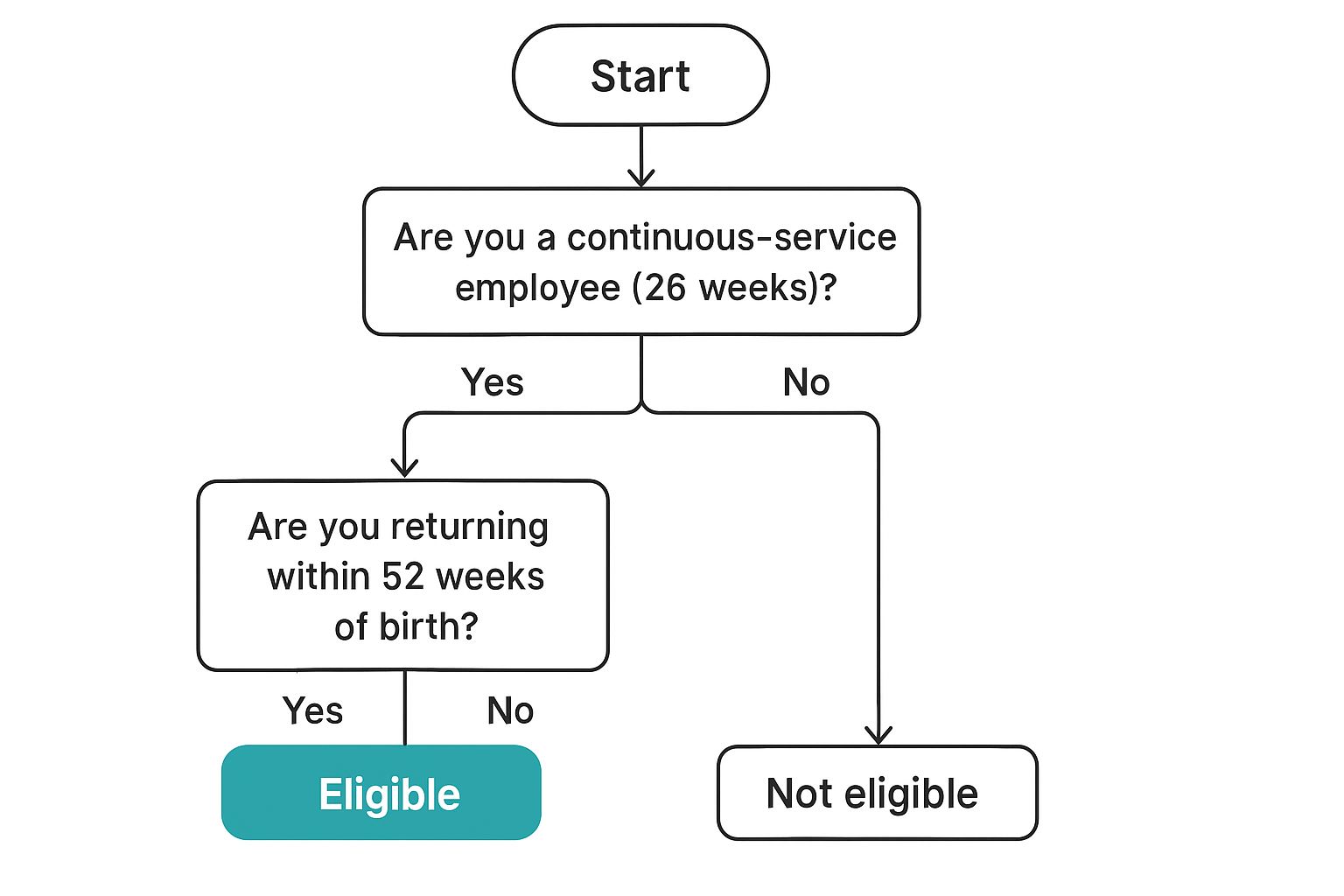A Practical Guide to Shared Parental Leave

Shared Parental Leave (SPL) gives eligible parents a much more flexible way to manage their time off after a new child arrives. Instead of the old, rigid maternity and paternity leave systems, SPL allows parents to share up to 50 weeks of leave and 37 weeks of statutory pay.
The whole idea is to give families more control over how they care for their child during that crucial first year. It’s a move away from traditional roles, opening the door for both parents to be deeply involved from the very beginning.
How Shared Parental Leave Actually Works

The best way to think about Shared Parental Leave is to picture all the available time and pay as one big, shareable pot. Once the mother or primary adopter takes their initial compulsory leave, whatever is left over can be divided up between both parents however they choose.
This system hinges on the mother or primary adopter choosing to end their maternity or adoption leave early. The untaken weeks of leave and pay don’t just disappear; they get converted into SPL, creating a flexible pool of time off that the family can use to suit their needs.
The Core Concept: A Flexible Pot of Time
Let’s make this concrete. Imagine a pot containing 52 weeks of maternity leave and 39 weeks of statutory pay. The law says the mother must take the first two weeks off after the birth (or four if she works in a factory).
After that compulsory period, the remaining 50 weeks of leave and 37 weeks of pay can be moved into the shared pot. From there, both parents can decide how to split it. You could take time off together right at the start, or you could stagger your leave, ensuring one parent is always at home for a longer period. This adaptability is what makes SPL so different.
The key takeaway is choice. Shared Parental Leave empowers parents to design a childcare arrangement that suits their family's financial, professional, and personal needs, rather than being locked into a one-size-fits-all model.
Key Benefits of the SPL System
This modern approach to family leave brings some significant advantages for parents and their employers:
- Greater Paternal Involvement: It actively encourages fathers and partners to take on a bigger caregiving role right from the start, which research shows has lasting positive effects on child development.
- Career Continuity for Mothers: Mothers can return to work earlier if they wish, without the family losing out on its total leave entitlement. This can help minimise the "motherhood penalty" on their career progression.
- Balanced Responsibilities: It allows a family to juggle childcare and work in a way that makes the most sense for their specific financial situation.
To put it all into perspective, here’s a quick summary of what the SPL scheme offers compared to the traditional model.
Shared Parental Leave at a Glance
| Feature | Details |
|---|---|
| Total Leave Available | Up to 50 weeks of leave can be shared between the parents. |
| Total Pay Available | Up to 37 weeks of statutory pay can be shared. |
| Flexibility | Leave can be taken in a single block, in separate blocks, or at the same time. |
| Eligibility | Both parents must meet specific employment and earnings criteria to qualify. |
Ultimately, SPL provides a framework for true partnership, giving families the tools to decide for themselves how to best navigate the first year of their child's life.
Figuring Out If You Qualify for SPL
Working out whether you and your partner can get Shared Parental Leave (SPL) might seem daunting at first, but it really boils down to a couple of key checks. The whole point of the system is to make sure both parents have a solid work history in the run-up to the baby’s arrival or adoption.
For the parent who plans to take the leave, the main thing to check is the 'continuity of employment' test. It’s simpler than it sounds. You just need to have been with the same employer for at least 26 continuous weeks by the end of the 15th week before your baby is due. Crucially, you also need to be on their payroll right up until you start your SPL.
What About Your Partner?
The other parent has a slightly different set of criteria to meet, known as the 'employment and earnings' test'. This one is a bit more flexible, designed to cover people who might be self-employed or have had a few different jobs recently.
To meet this test, your partner must have:
- Worked for a total of at least 26 weeks within the 66 weeks before the baby’s due date. These weeks don't have to be all in a row.
- Earned at least £30 a week on average in any 13 of those weeks.
Think of it as a two-part check: one for the primary leave-taker, one for their partner. Getting your head around these two separate tests is the first real step to planning your time off with confidence. It's also helpful to see how SPL sits alongside other entitlements, which you can read about in our guide on the essential types of leave in the UK.
This handy decision tree can help you visualise the main questions you need to ask.

As you can see, it all comes down to one parent having continuous service and the other having a recent work record. Get those two things sorted, and you're well on your way.
How This Works in Practice
Let’s put this into a real-world scenario. Say Sarah has been a full-time employee at her company for three years. She sails through the continuity of employment test. Her partner, Tom, works as a self-employed contractor. As long as Tom can show he’s worked for at least 26 of the past 66 weeks and hit that minimum earnings level, he passes his test too. Just like that, they're both eligible for SPL.
At its heart, the rule is simple: if one parent has a stable job and the other has a proven recent work history, the family can benefit from the flexibility SPL offers. It’s designed to work for all sorts of modern family setups.
Despite how flexible the scheme is, not many people are actually using it. Since it was launched back in 2015, only around 5% of eligible fathers have taken SPL. The biggest reason? Money worries. This just goes to show that knowing you're eligible is only half the battle; understanding the financial implications is just as important.
Understanding Your Shared Parental Pay

Let's talk about the most common question families have when considering Shared Parental Leave (SPL): how does the pay work? Getting a clear picture of the financials is absolutely essential before you decide if this is the right path for your family.
First things first, it's crucial to understand the difference between what the law mandates and what your employer might offer on top.
The government sets a legal minimum, which is called statutory pay. For the 2025/26 tax year, the statutory rate is £187.18 per week, or 90% of your average weekly earnings if that figure is lower. This is the absolute baseline an employer must pay to eligible employees.
But many companies know that statutory pay alone can put a real strain on family finances, so it’s always worth digging into your specific company's policy.
Statutory vs Enhanced Pay
Think of statutory pay as the floor – the legal minimum. Some employers choose to build on this by offering what’s known as enhanced or contractual Shared Parental Pay.
This is a game-changer. An enhanced policy might mean your employer tops up your pay to a higher percentage of your usual salary, or even offers full pay for a certain number of weeks. This generosity can transform SPL from a financially tricky option into a brilliant opportunity for your family.
Your first port of call should be your employment contract or the company handbook. That’s where you’ll find the details of what’s on offer.
The availability of an enhanced pay scheme is often the single most important factor in whether a family can afford to use Shared Parental Leave. It bridges the gap between statutory minimums and real-world living costs.
The Financial Barrier to Taking Leave
There's no getting around it: money is the main reason many eligible parents don't take up SPL. Research has found that finances are the primary barrier for one in four mothers and one in three fathers. When you stack the statutory rate up against a full-time salary, it’s easy to see how the numbers just don't add up for many, forcing them to cut their leave short or avoid SPL altogether. You can read more about this in the government's evaluation report on Shared Parental Leave.
This really underlines why careful planning and budgeting are so important. Before you make any firm decisions, sit down and map out your finances.
Consider these key points:
- Household Income: How will your income change on statutory or enhanced pay?
- Monthly Bills: Are there any regular outgoings you can pause or reduce temporarily?
- Savings: Do you have a financial cushion to fall back on to make things more comfortable?
By taking the time to review your employer’s policy and create a realistic budget, you can make a clear-headed, informed decision that truly works for your family’s financial well-being.
How to Plan and Book Your Leave
The real beauty of Shared Parental Leave (SPL) is its flexibility. But with that freedom comes a bit of homework. Unlike the old-school, one-size-fits-all approach, SPL lets you design a leave plan that truly works for your family—whether you want to take time off together, tag-team the childcare, or break it up into chunks.
First things first, sit down and think about what you actually want. Are you dreaming of one long, continuous block of time to really settle into family life? Or would splitting it into a few smaller periods make more sense for your jobs and childcare plans? There’s no right or wrong answer here; it’s all about what suits you.
Structuring Your Shared Parental Leave
You can slice and dice your SPL in three main ways. Getting your head around these will help you map out that first year so it supports everyone.
- Continuous Leave: This is the simplest option. One parent takes a single, unbroken chunk of leave. It’s straightforward and easy for everyone to plan around.
- Discontinuous Leave: Here, you take leave in separate blocks, with periods of work in between. This is a great choice if you want to ease back into your role or spread out the childcare over a longer period.
- Concurrent Leave: Both parents can be off at the same time. It's perfect for those chaotic but precious early weeks, letting you bond with your baby and support each other as a team.
For example, one couple might decide the mother will take the first six months, and the father will take the following three. Another might take the first month off together, then alternate every couple of months so one parent is always home while the other can focus on their career.
How Parents Are Using SPL in Reality
While the system is designed for flexibility, the data shows that most families keep it simple. The vast majority of parents who take SPL choose to take it in one continuous block.
Research from the government shows that 83% of parents took their leave 'all as one,' with only 15% breaking it into separate chunks. It’s also interesting to see that 35% of parents took leave at the same time as their partner, while 45% took it at different times. You can dig into more of these findings in the Parental Leave Review on GOV.UK.
This tells us that while the option to get creative is there, many families still prefer the predictability of a single, solid block of time off.
Whatever you decide, don’t forget to bring your annual leave into the equation. A lot of parents cleverly use their paid holidays to top up their time off, extending their leave without taking a hit on their shared parental pay. It's a smart move. If you're unsure how that works, our guide on how to calculate pro-rata holiday entitlement in the UK can help you figure it out.
Ultimately, getting your SPL plan right comes down to open conversations—with your partner and your employer. By exploring all the possibilities, you can build a schedule that works for your family, your finances, and your careers.
Knowing Your Rights and Employer Obligations

When it comes to Shared Parental Leave, knowing where you stand legally is everything. It allows you to approach the conversation with your employer confidently, armed with the facts. Thankfully, UK law offers solid protection to make sure you aren't penalised for taking time to care for your new child.
The cornerstone of these protections is your right to return to your job. It’s a simple but powerful guarantee. If your total time off—that’s any combination of maternity, paternity, adoption, and shared parental leave—is 26 weeks or less, you’re legally entitled to come back to the exact same role. Same responsibilities, same pay, same desk.
Take more than 26 weeks, and the rules shift slightly. You still have the right to return, but if it’s not reasonably practical for your employer to give you your old job back, they must offer you a suitable alternative. This new role has to have the same (or better) terms and conditions.
The Formal Notification Process
So, how do you kick things off? There's a formal notice period, and it’s not just about ticking boxes. Giving your employer proper notice is crucial because it gives them the time to arrange cover and plan for your absence, which makes life easier for everyone.
You’ll need to give your employer at least eight weeks' notice before you plan to start a block of leave. This isn't just a heads-up; your notice needs to include some specific details:
- The total amount of leave each parent is entitled to.
- A clear breakdown of how much leave each of you plans to take.
- The exact start and end dates for the block of leave you're booking.
Think of this as a formal but collaborative conversation. Providing clear, timely information allows your employer to support you effectively and ensures a smooth handover, benefiting both you and your team.
Your Employer's Responsibilities
Once you’ve submitted your notice, the ball is in your employer's court. They have a clear set of responsibilities and are legally bound to treat your request fairly. You can't be put at a disadvantage—like being passed over for a promotion or being selected for redundancy—just because you've opted for SPL.
Here’s what you can expect from them:
- A prompt response: They have 14 days to formally respond to your leave notice.
- Keeping you in the loop: They should keep you updated on important workplace news, like promotion opportunities or team changes, while you're away.
- Protecting your benefits: Your employment contract continues throughout your leave. This means you’ll keep accruing things like annual leave and other contractual benefits.
Understanding these rules on both sides helps ensure the whole process is transparent, fair, and positive for everyone involved.
How an Annual Leave Tracker Tames SPL Complexity
Let's be honest: juggling blocks of Shared Parental Leave, annual holidays, and work commitments can feel like a high-stakes game of Tetris. The flexibility that makes SPL so brilliant is also what makes it an administrative nightmare. Spreadsheets creak, paper forms get lost, and wires get crossed. This is where a simple, dedicated tool changes everything.
For parents, a good leave tracker acts like a personal calendar, giving you a crystal-clear map of the entire year ahead. You can plot out your SPL blocks, see exactly how your annual leave slots in around them, and make sure not a single precious holiday day is wasted. That kind of clarity is gold when you're trying to plan your finances and organise a smooth handover at work.
For HR managers and business owners, the relief is even greater. Moving to a central system eliminates the guesswork and helps you dodge costly mistakes.
One Place for All Things Leave
Instead of digging through endless email chains or wrestling with a colour-coded-to-death spreadsheet, a tracker gives you a single source of truth. It provides a clean, at-a-glance overview of who is off and when—absolutely vital for preventing scheduling clashes and ensuring the team isn't left short-staffed. This turns a potentially chaotic process into something simple and manageable.
Here’s a perfect example of how a tracker gives you that instant visual clarity, making it easy to spot any overlaps.
This kind of calendar view immediately shows all approved time off, clearly marking different types like shared parental leave, sick days, and annual holidays. It takes the pain out of resource planning and keeps the wheels turning smoothly while an employee is away.
An effective leave tracker stops you from just reacting to SPL requests and lets you proactively manage them. It ensures payroll is spot on, keeps you compliant, and offers peace of mind to both the employee and the business.
At the end of the day, using a digital tool just helps everyone stay organised. It can handle everything from the initial booking right through to tracking those 'keeping in touch' days with total accuracy. If you're ready to ditch the spreadsheets for good, you can find out more in our guide to online leave management systems, which digs into how these tools support modern, flexible workplaces.
Got Questions About Shared Parental Leave? We’ve Got Answers.
Even when you've got a decent handle on Shared Parental Leave (SPL), a few specific questions always seem to crop up. Getting straight answers to these common queries can make the whole process feel a lot less daunting.
Let's dive into some of the most frequent questions parents ask, giving you the clarity you need to plan with confidence.
Can We Change Our Shared Parental Leave Plan Once It's Booked?
Yes, you absolutely can. The system has built-in flexibility, but the key is to give your employer at least eight weeks' notice before any new dates kick in.
You're officially allowed to submit up to three separate notices to book or change your leave. That said, most employers are happy to have an informal chat first, so it’s always a good idea to talk to them as soon as you think your plans might shift.
How Do Keeping in Touch Days Work with SPL?
During Shared Parental Leave, both you and your partner can each use up to 20 'Keeping in Touch' (or 'SPLIT') days. These are paid work days that let you dip back into your job without officially ending your leave period.
They’re brilliant for attending a key meeting, catching up with your team, or just making the eventual return to work feel a bit smoother. Just make sure you agree on the work and pay for these days with your employer beforehand.
These days are a fantastic tool for staying in the loop professionally. They help bridge the gap, which is great for you and good for the business.
What Happens to My Pension and Benefits While I'm on Leave?
Don't worry, your fundamental employment rights are protected while you're on SPL. This includes important things like continuing to accrue your annual leave.
As for your pension, your employer must keep up their contributions based on your normal salary for any period you're receiving statutory or enhanced Shared Parental Pay. Your own contributions, however, will be based on the actual pay you receive during leave. It's always smart to double-check your company's specific policies on other contractual benefits, just to be sure.
Juggling SPL requests, tracking who’s off when, and keeping everyone in the loop can quickly become a headache. Annual Leave Tracker takes the pain out of the process with a simple, clear platform, letting you ditch the confusing spreadsheets for good. Find out how easy leave management can be at https://www.annualleavetracker.com.
Ready to Transform Your Leave Management?
Join 500+ companies using Annual Leave Tracker to streamline their HR processes.


